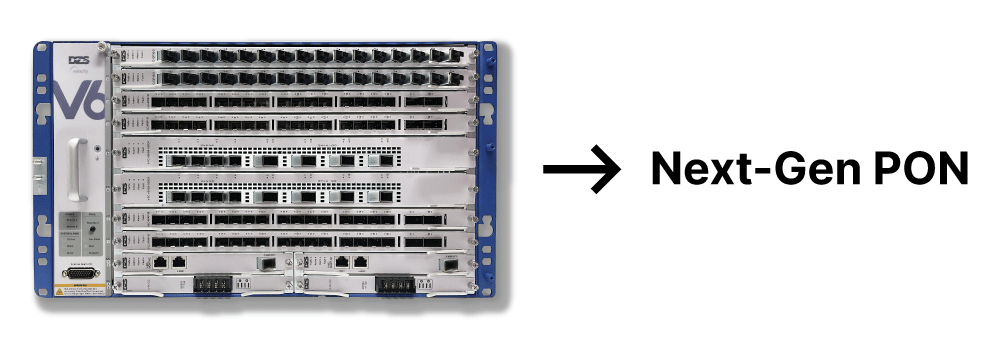As the demand for faster and more reliable internet connectivity continues to grow, network operators are seeking innovative solutions to meet the escalating requirements of modern applications and services. Enter 50G Passive Optical Networks (PON) — a groundbreaking evolution in fiber technology that promises to redefine broadband connectivity.
The Need for 50G PON
Modern applications like 8K video streaming, virtual and augmented reality (VR/AR), gaming, remote working, smart cities, and Industry 4.0 demand unprecedented levels of bandwidth and ultra-low latency. Legacy networks, even those employing 10G or 25G PON technologies, will have limitations as they struggle to cope with the rising demands on the network.
50G PON addresses these challenges head-on by delivering:
- Higher Bandwidth: With a capacity of 50 Gbps, it provides the scalability needed to support bandwidth-intensive applications and multiple high-speed connections simultaneously.
- Reduced Latency: Designed to minimize delays, it ensures seamless performance for real-time applications like gaming, telemedicine, and autonomous vehicles.
- Future-Proofing Networks: By adopting 50G PON, service providers can build infrastructure that not only meets today’s needs but also supports innovations on the horizon.
Key Drivers of Adoption
- Exponential Data Growth: With the proliferation of IoT devices and cloud-based services, global data traffic is expanding at an unprecedented rate. 50G PON provides a robust backbone to accommodate this growth.
- Digital Transformation: Enterprises undergoing digital transformation require reliable, high-speed networks for operations like AI processing, big data analytics, and edge computing.
- Consumer Expectations: Residential users now expect multi-gigabit speeds as standard, and 50G PON ensures they have the bandwidth required for evolving digital lifestyles.
- New WiFi Technology Standards: WiFi7, which is already seeing rapid adoption which will only accelerate in the near future, is a robust new wireless technology that is capable of supporting up to 44 Gbps in the home. This technology will expand the expectations for the underlying access technologies feeding it. 10G PON and 25G PON will fall short over time – 50G PON is the only access standard that can match its capabilities.
Industry Impacts
The adoption of 50G PON will have far-reaching implications across industries. For telecom operators, it offers a cost-effective way to upgrade existing GPON/10G PON networks. For consumers and businesses, it enables access to transformative technologies that rely on high-speed, low-latency connectivity. Additionally, governments and municipalities can leverage 50G PON to accelerate smart city initiatives, bridging the digital divide and fostering innovation. Furthermore, with the majority of communications service providers globally now having made the investment in at least part if not most of their networks, 50G PON provides a continued path to providing return on that investment through new monetizable services over their existing infrastructure. With 50G PON’s ability to co-exist on the same Optical Distribution Network (ODN), these service providers can seamlessly grow their network to the next generation of PON without interrupting their existing customers and services. It should be noted that solutions like 25G PON being touted by some vendors today do NOT offer the same seamless transition. 25G PON was introduced as predominantly a single vendor solution, which results in some potential co-existence challenges. 50G PON, however, is a multi-vendor solution that offers full co-existence and enables service providers to seamlessly grow their network alongside GPON and 10G PON.
Other Positive Implications
50G PON has also been chosen by some merchant silicon vendors as the launch point for embedded Artificial Intelligence in the access networks. The implications for this are far-reaching, with potential breakthrough opportunities for superior network management, energy efficiency and optimization, and security.
DZS at 50G PON
At DZS, we have anticipated 50G PON as a seminal transition point for the industry for many years. Our Velocity portfolio of access solutions are unique in the industry for being architected to embrace this technology in existing chassis without forklift upgrades. With a capacity of over 800 Gbps on each of our system-on-a-card line cards, and a non-blocking architecture, moving to 50G PON for DZS customers will be as simple as the addition of a new line card. We are excited for the potential of this new technology and believe that service providers should be considering their future transition to this technology when they are evaluating any PON solutions today.

For more information on 50G PON and the DZS next generation PON strategy, please use the following resources:
- Cady Talks: 50G PON and the Future of Fiber Access: https://www.youtube.com/watch?v=mOx7mc7bxFQ
- Cady Talks: The State of PON – Fugure of Broadband Access Technologies: https://www.youtube.com/watch?v=kVviSOMhx0Y
- DZS Fiber Access: Fiber Access – DZS



 '
'